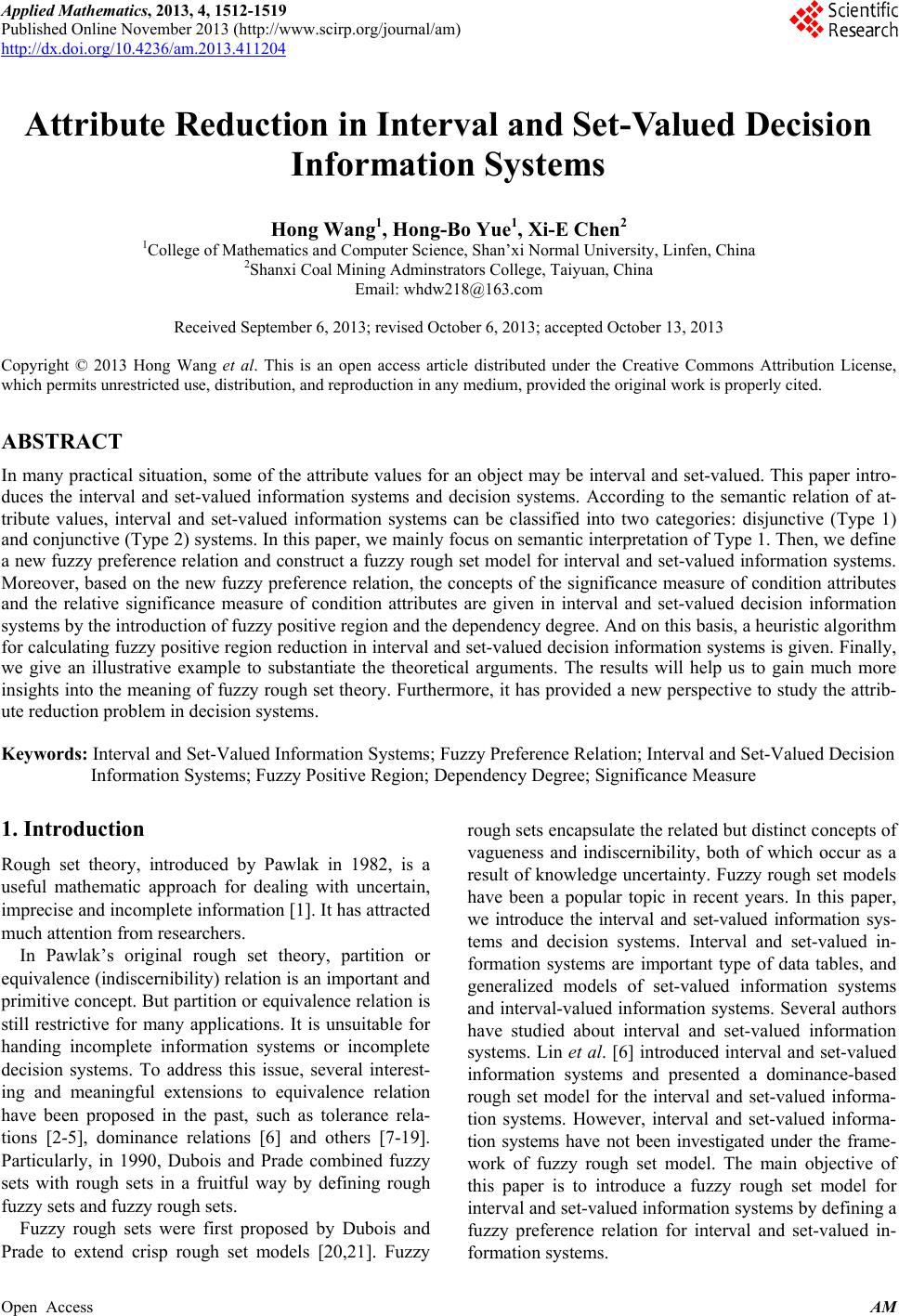 Applied Mathematics, 2013, 4, 1512-1519 Published Online November 2013 (http://www.scirp.org/journal/am) http://dx.doi.org/10.4236/am.2013.411204 Open Access AM Attribute Reduction in Interval and Set-Valued Decision Information Systems Hong Wang1, Hong-Bo Yue1, Xi-E Chen2 1College of Mathematics and Computer Science, Shan’xi Normal University, Linfen, China 2Shanxi Coal Mining Adminstrators College, Taiyuan, China Email: whdw218@163.com Received September 6, 2013; revised October 6, 2013; accepted October 13, 2013 Copyright © 2013 Hong Wang et al. This is an open access article distributed under the Creative Commons Attribution License, which permits unrestricted use, distribution, and reproduction in any medium, provided the original work is properly cited. ABSTRACT In many practical situation, some of the attribute values for an object may be interval and set-valued. This paper intro- duces the interval and set-valued information systems and decision systems. According to the semantic relation of at- tribute values, interval and set-valued information systems can be classified into two categories: disjunctive (Type 1) and conjunctive (Type 2) systems. In this pape r, we mainly focus on semantic interpretatio n of Type 1. Then, we define a new fuzzy preference relation and construct a fuzzy rough set model for interval and set-v alued information systems. Moreover, based on the new fuzzy preference relation, the concepts of the significance measure of condition attributes and the relative significance measure of condition attributes are given in interval and set-valued decision information systems by the introduction of fuzzy positive region and the depend ency degree. And on this b asis, a heuristic algorithm for calculating fuzzy positive region reduction in interval and set-valued decision information systems is given. Finally, we give an illustrative example to substantiate the theoretical arguments. The results will help us to gain much more insights into the meaning of fuzzy rough set theory. Furthermore, it has provided a n ew perspective to study the attrib- ute reduction problem in decision systems. Keywords: Interval and Set-Valued Information Systems; Fuzzy Preference Relation; Interval and Set-Valued Decision Information Systems; Fuzzy Positive Region; Dependency Degree; Significance Measure 1. Introduction Rough set theory, introduced by Pawlak in 1982, is a useful mathematic approach for dealing with uncertain, imprecise and incomplete information [1]. It has attracted much attention from researchers. In Pawlak’s original rough set theory, partition or equivalence (indiscernibility) relatio n is an important and primitive concept. But partition or equiva lence relation is still restrictive for many applications. It is unsuitable for handing incomplete information systems or incomplete decision systems. To address this issue, several interest- ing and meaningful extensions to equivalence relation have been proposed in the past, such as tolerance rela- tions [2-5], dominance relations [6] and others [7-19]. Particularly, in 1990, Dubois and Prade combined fuzzy sets with rough sets in a fruitful way by defining rough fuzzy sets and fuzzy rough sets. Fuzzy rough sets were first proposed by Dubois and Prade to extend crisp rough set models [20,21]. Fuzzy rough sets encapsulate the related but distinct concepts of vagueness and indiscernibility, both of which occur as a result of knowledge uncertainty. Fuzzy rough set models have been a popular topic in recent years. In this paper, we introduce the interval and set-valued information sys- tems and decision systems. Interval and set-valued in- formation systems are important type of data tables, and generalized models of set-valued information systems and interval-valued information systems. Several authors have studied about interval and set-valued information systems. Lin et al. [6] introduced interval and set-valued information systems and presented a dominance-based rough set model for the interval and set-valued informa- tion systems. However, interval and set-valued informa- tion systems have not been investigated under the frame- work of fuzzy rough set model. The main objective of this paper is to introduce a fuzzy rough set model for interval and set-valued information systems by defining a fuzzy preference relation for interval and set-valued in- formation systems. 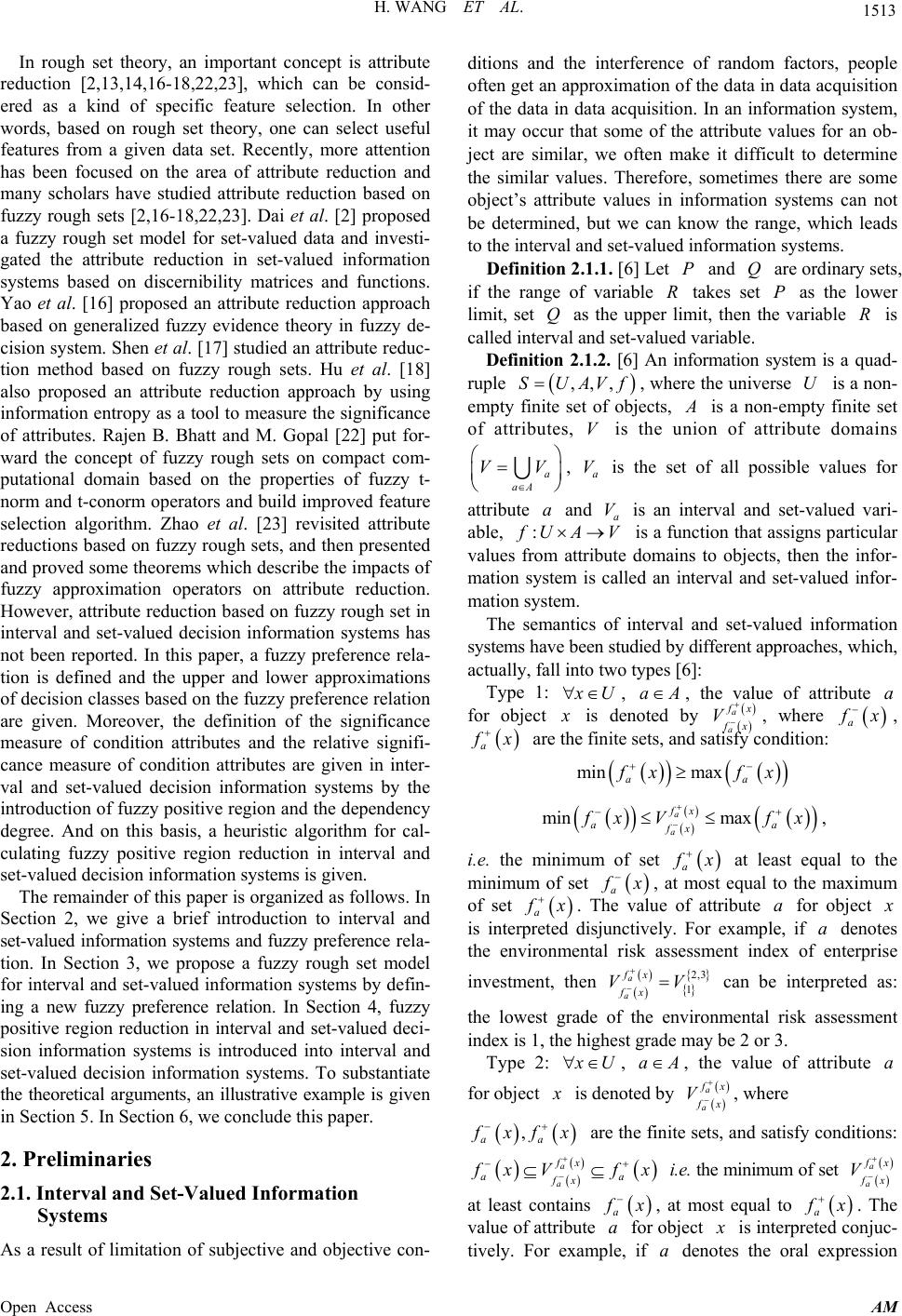 H. WANG ET AL. 1513 In rough set theory, an important concept is attribute reduction [2,13,14,16-18,22,23], which can be consid- ered as a kind of specific feature selection. In other words, based on rough set theory, one can select useful features from a given data set. Recently, more attention has been focused on the area of attribute reduction and many scholars have studied attribute reduction based on fuzzy rough sets [2,16-18,22,23]. Dai et al. [2] proposed a fuzzy rough set model for set-valued data and investi- gated the attribute reduction in set-valued information systems based on discernibility matrices and functions. Yao et al. [16] proposed an attribute reduction approach based on generalized fuzzy evidence theory in fuzzy de- cision system. Shen et al. [17] studied an attribute reduc- tion method based on fuzzy rough sets. Hu et al. [18] also proposed an attribute reduction approach by using information entropy as a tool to measure the significance of attributes. Rajen B. Bhatt and M. Gopal [22] put for- ward the concept of fuzzy rough sets on compact com- putational domain based on the properties of fuzzy t- norm and t-conorm operators and build improved feature selection algorithm. Zhao et al. [23] revisited attribute reductions based on fuzzy rough sets, and then presented and proved some theorems which describe the impacts of fuzzy approximation operators on attribute reduction. However, attribute reduction based on fuzzy rough set in interval and set-valued decision information systems has not been reported. In this paper, a fuzzy preference rela- tion is defined and the upper and lower approximations of decision classes based on the fuzzy preference relation are given. Moreover, the definition of the significance measure of condition attributes and the relative signifi- cance measure of condition attributes are given in inter- val and set-valued decision information systems by the introduction of fuzzy positive reg ion and the dependency degree. And on this basis, a heuristic algorithm for cal- culating fuzzy positive region reduction in interval and set-valued decision information systems is given. The remainder of this paper is organized as follows. In Section 2, we give a brief introduction to interval and set-valued information systems and fuzzy preference rel a- tion. In Section 3, we propose a fuzzy rough set model for interval and set-valued information systems by defin- ing a new fuzzy preference relation. In Section 4, fuzzy positive region reduction in interval and set-valued deci- sion information systems is introduced into interval and set-valued decision information systems. To substantiate the theoretical arguments, an illustrative example is given in Section 5. In Section 6, we conclude this paper. 2. Preliminaries 2.1. Interval and Set-Valued Information Systems As a result of limitation of subjective and objective con- ditions and the interference of random factors, people often get an approximation of the data in data acquisition of the data in data acquisition. In an information system, it may occur that some of the attribute values for an ob- ject are similar, we often make it difficult to determine the similar values. Therefore, sometimes there are some object’s attribute values in information systems can not be determined, but we can know the range, which leads to the interval and set-valued information systems. Definition 2.1.1. [6] Let and Q are ordinary sets, if the range of variable takes set as the lower limit, set as the upper limit, then the variable is called interval and set-valu ed variable. P R P Q R Definition 2.1.2. [6] An information system is a quad- ruple ,,,SUAVf, wher e the univ erse is a non- empty finite set of objects, U is a non-empty finite set of attributes, V is the union of attribute domains a aA VV a V, is the set of all possible values for attribute and is an interval and set-valued vari- able, a :a V UA V is a function that assigns particular values from attribute domains to objects, then the infor- mation system is called an interval and set-valued infor- mation system. The semantics of interval and set-valued information systems have been studied by different approaches, whi c h , actually, fall into two types [6]: Type 1: U , aA , the value of attribe a for objt ut ec is denote d by a a x x V , where a x , a x are the finite sets, and satisfy condition: min max aa xfx min max a a fx aa fx xV fx , i.e. the minimum of set a x at least equal to the minimum of set a x , at most equal to the maximum of set a x . The value of attribute for object a is interpreted disjunctively. For example, if denotes the environmental risk assessment index of enterprise a investment, then can be interpreted as: 2,3 1 a a fx fx VV the lowest grade of the environmental risk assessment index is 1, the highest gr ade may be 2 or 3. Type 2: U , aA , the value of attribute a for object is denoted by a a x x V , where , aa fxfx are the finite sets, and satisfy conditions: a a fx a fx fx Vfx a i.e. the minimu m of se t a a x x V at least contains a fx , at most equal to a fx . The value of attribute afor object is interpreted conjuc- tively. For example, if adenotes the oral expression Open Access AM 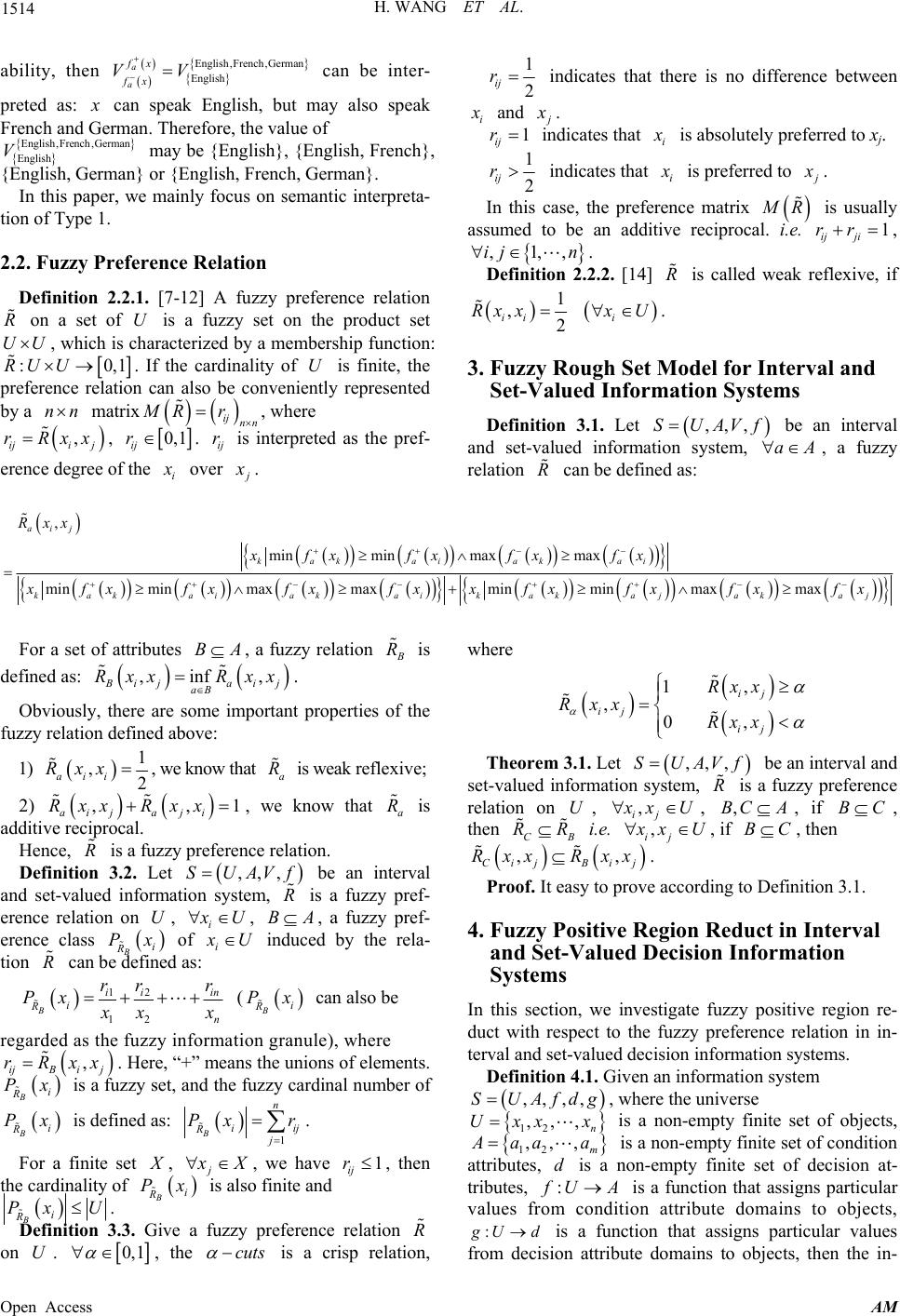 H. WANG ET AL. Open Access AM 1514 1 2 ij r indicates that there is no difference between ability, then can be inter- English,French,German English a a fx fx VV preted as: can speak English, but may also speak French and German. Therefore, the value of i and . 1 ij indicates that i is absolutely preferred to xj. r may be {English}, {English, French }, {English, German} or {English, French, German}. English,French,German English V In this paper, we mainly focus on semantic interpreta- tion of Type 1. 2.2. Fuzzy Preference Relation Definition 2.2.1. [7-12] A fuzzy preference relation on a set of U is a fuzzy set on the product set , which is characterized by a membership function: R UU :U nn ,xx 0,1RU rR . If the cardinality of is finite, the preference relation can also be conveniently represented by a matrix , where U ij nn MRr ijij, 0,1 r ij r. is interpreted as the pref- ij erence degree of the i over . 1 2 ij r indicates that i is preferred to . In this case, the preference matrix R is usually assumed to be an additive reciprocal. i.e. 1 ij ji rr , ,1,,ij n. Definition 2.2.2. [14] is called weak reflexive, if R 1 ,2 ii Rxx i U . 3. Fuzzy Rough Set Model for Interval and Set-Valued Information Systems Definition 3.1. Let be an interval and set-valued information system, , a fuzzy relation can be defined as: ,,,SUAVf aA R , minmin maxmax min minmax maxmin minmax max aij kak aiakai kak aiakaikak ajakaj Rxx xfxfx fxfx x fxfxfxfxx fxfxfxfx For a set of attributes , a fuzzy relation BA R is defined as: ,,inf ij aij aB Rxx xx R . Obviously, there are some important properties of the fuzzy relation defined above: 1) 1 ,2 aii Rxx , we know that is weak reflexive; a R 2) , we know that is additive reciprocal. ,, aija ji RxxRxx 1 a R Hence, is a fuzzy preference relation. R Definition 3.2. Let be an interval and set-valued information system, is a fuzzy pref- erence relation on , ,,,SUAVfR i U U B i , , a fuzzy pref- erence class Bi R of A xP U induced by the rela- tion can be d efined as: R 12 12 B ii i i Rn rr r Px n xx ( can also be Bi R Px regarded as the fuzzy information granule), where , ijB i j rRxx Bi R Px . Here, “+” means the unions of elements. is a fuzzy set, and the fuzzy cardinal number of Bi R Px is defined as: 1 B n ii Rj Px r j . For a finite set , j X , we have 1 ij r , then the cardinality of is also finite and i x B R P Bi R Definition 3.3. Give a fuzzy preference relation on . Px U. R U 0,1 , the cuts is a crisp relation, where 1, ,0, ij ij ij Rxx Rxx Rxx Theorem 3.1. Let ,,,SUAVfR , ij b e an interval and set-valued information system, is a fuzzy preference relation on U, xU ,BC , ij , , if , then i.e. ABC C R B R xU , if , then BC x,,x CijBij RxxR . Proof. It easy to prove according to Definition 3.1. 4. Fuzzy Positive Region Reduct in Interval and Set-Valued Decision Information Systems In this section, we investigate fuzzy positive region re- duct with respect to the fuzzy preference relation in in- terval and set-valued decision information systems. Definition 4.1. Given an information system ,, ,,SUAfdg, where the universe 12 ,,, n Uxx x is a non-empty finite set of objects, 12 ,,, m aa a d :fU : is a non-empty finite set of condition attributes, is a non-empty finite set of decision at- tributes, is a function that assigns particular values from condition attribute domains to objects, A Ud is a function that assigns particular values from decision attribute domains to objects, then the in- 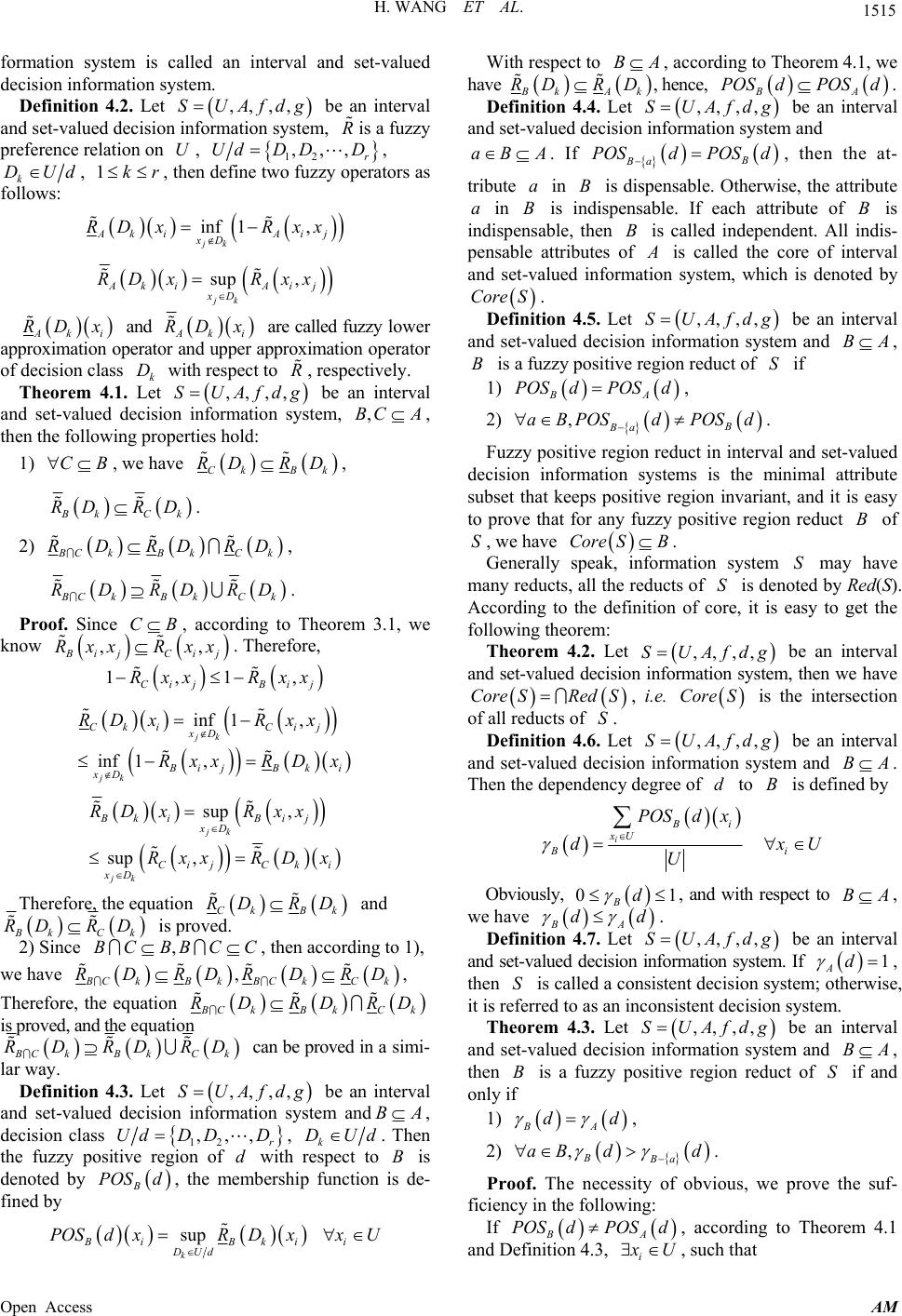 H. WANG ET AL. 1515 formation system is called an interval and set-valued decision information system. Definition 4.2. Let be an interval and set-valued decision information system, is a fuzzy preference relation on , ,,,,SUAfdg U R 12 ,,Ud DD,Dr, k DUd, , then define two fuzzy operators as follows: 1kr inf 1, jk Ak iAij xD RD xRxx sup , jk Ak iAij xD RD xRxx Ak i RD x and Ak i RD x are called fuzzy lower approximation operator and upper approximation oper ator of decision class with respect to , respectively. k Theorem 4.1. Let be an interval and set-valued decision information system, , then the following properties hold: D R ,dg ,, ,SUAf ,BCA 1) , we have CB Ck Bk RD RD , kC RD RD k . 2) CkBkCk RDRDRD , CkBk Ck RDRDRD . Proof. Since , according to Theorem 3.1, we know CB , , ij ij Rx xx x C x R 1,Rx . Therefore, 1, Cij Bij Rxx inf 1, inf 1, jk jk Ck iCij xD ijB ki xD RD xRxx RxxRD x sup , sup , jk jk Bk iBij xD CijCki xD RD xRxx RxxRD x Therefore, the equation Ck Bk RD RD and kCk RD RD is proved. 2) Since , then according to 1), ,BCBBC C we have , CkBkBCkCk RDRDRDRD , Therefore, the equation CkBkCk RDRDRD is proved, and the equation CkBkCk RDRDRD can be proved in a s i mi - lar way. Definition 4.3. Let be an interval and set-valued decision information system and, decision class ,,,,SUAfdg BA 12 ,,, r DD DUd, k d DUd B . Then the fuzzy positive region of with respect to is denoted by , the membership function is de- fined by B POS d sup k Bi Bkii DUd POS d xRDxxU With res p ec t to , according to Theorem 4.1, we have BA kAk RD , he RD nce, BA POS dPOS d. Definition 4.4. Let ,, ,,UAfdg be an interval and senformati S t-valued decisio and n ion system aB A . If dPOS d n Otherwi in spensable. If each attr B Ba POS , then the at- tribute a is dispesable.in Bse, the attribute is indibute of B is a pe B e i indispensable, then B is called independent. All indis- nsablattributes of is called the core of intval and set-valued informtion system, which is denoted by er a Core S. Definition 4.5. Let ,,,,SUAfdg be an interval and set-valued decisio and n information system on reduct of SBA , B is a fuzzy positive regi if 1) BA POS dPOS d, 2) ,OSd POSd B Ba aBP . Fuzzy mi positive region reduct in interval and set-valued decision information systems is the nimal attribute subset that keeps positive region invariant, and it is easy to prove that for any fuzzy positive region reduct B of S, we have Core SB. Generally speak, information system S may ave h many reducts, all the reducts of Red(S). AS is denoted by ccording to the definition of core, it is easy to get the following theorem: Theorem 4.2. Let ,,,,SUAfdg be an interval and set-valued decisio, then we have n information system re SRedS, the intersection of all reducts of S. t Co i.e. Core S is Definition 4.6. Le ,S g be an interval and set-valued deisi,, ,UAfd n information system gree of d to B co and Th BA. en the dependency de is defined by i Bi xU POS dx dxU Bi U 01 Bd ,Obviously, and with respect t we have o BA, BA dd . 4.7. Let Definition ,, ,,UAfdg be an il and set-vaSnterva lued decision If information system. 1 Ad , th em. en S is called a constem; otherwise, it is referred to as an inconsistent decision syst Theorem 4.3. Let sistent decision sy ,,,,SUAfdg be an interval and set-valued decision information system and BA, then B is a fuzzy poct of S if and only if 1) sitive region redu BA dd , 2) ,BBa aB dd . of. The necessity of obvious, we prove the suf- ficiency in the following: Pro If BA POS dPOS d, according to Theorem 4.1 and Definition 4.3, i U , such that O pen Access AM 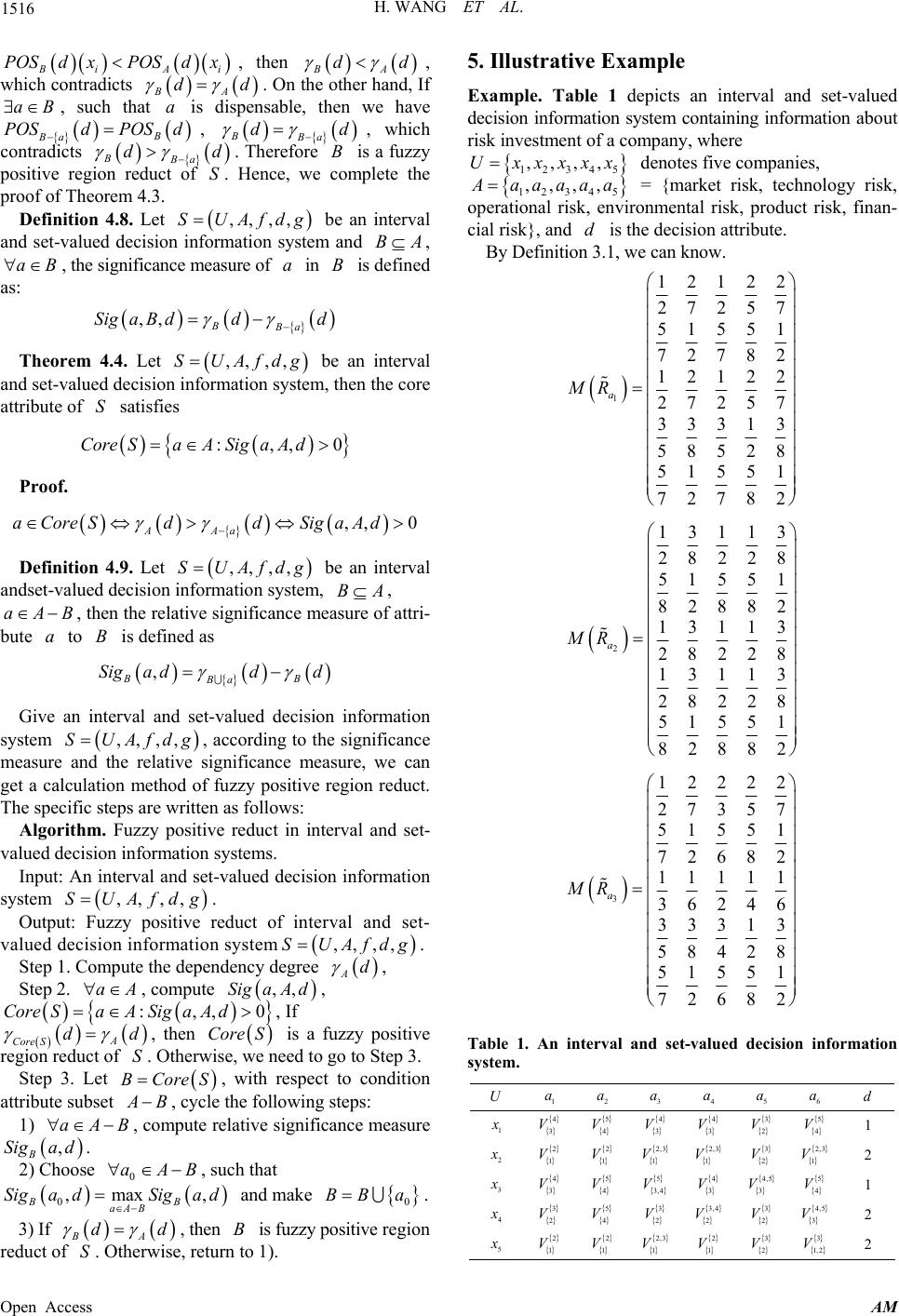 H. WANG ET AL. 1516 i i S, then A POd xPOS dx BA dd , which contradicts d . On th pensable, Ba POSdPO BBad , which cts Bdd . Ther efore B is a fuzzy lete the proof of Theore Definition 4.8. Let ,,,,SUAfdg be an interval and set-valued decision B d aB, such that a is dis B Sd , contradi Ba positive region reduct of S m 4.3. inform me A . Hence, ation sy asure of e other hand, I then we have d we comp stem and BA in f , aB, the significance B is defined as: a ,,Siga B ddd g be an interval m, then the core ,, 0SigaA d ,g be an interval , BA, m B on information gnificance ,,,,SUAfdg. B Theorem 4.4. Let SU and set-valued decision inform att s or Proof. AAa a Sd Definition 4.9. Let SU andset-valued decision inform ative signi a Si Give an interval and set-va system ,,,,SUAfdg measure a lculation method o ecision information sys Ba ,,fd ation syste ,fd ation system cance lued decisi , according to the si m ,,A d ,,A fi te ribute of S satisfie :,,0CeSaASigaA d Core AB, then the relaeasure of attri- bute a to B is defined as , B B ga ddd nd the relative significance measure, we can get a caf fuzzy positive region reduct. The specific steps are written as follows: Algorithm. Fuzzy positive reduct in interval and set- valued decision information systems. Input: An interval and set-valued decision information system ,,,,SUAfdg. Output: Fuzzy positive reduct of interval and set- valued d Step 1. Compute the dependency degree A ,d, is a zzy positive need to go to Step 3. d , Step 2. aA, compute ,Siga A :,,0reSaASigaAd , If Co A C r region reduct of S. Otherwise, Step 3. Let B, ore Sdd, then Co fu CoreS respect to condition attribute subset e S we with B, cycle the following steps: 1) aAB lative significance measure , B Siga d. , compute re hoose a ,max , aAB Sig adSig ad 2) C0AB, such that 0BB and make 0 BB a positive regio . 5.trative Exam al and set-valued ntaining information abo ut 3) If BA dd , then reduct of S. Otherwise, returnB is fuzzy n to 1). Illusple an intervExample. Table 1 depicts decision information system co risk investment of a company, where 12345 ,,,,U xxxxx denotes five companies, 12345 ,,,, aaaaa = {market risk, ronmental risk, product risk he decision attribute. By Definition 3.1, we can kn ow. technology risk, , finan-operational risk, envi cial risk}, and d is t 1 12122 272 57 51551 72782 12122 27 25 7 33313 58528 51551 72782 a MR 2 13113 28228 51551 82882 13113 28228 13113 28228 51551 82882 a MR 3 12222 27 3 57 51551 72682 11111 36246 33313 58 428 51551 72682 a MR Table 1. An interval and set-valued decision information system. U a a a a a a d 1 2 345 6 1 4 3 V 5 4 V 4 3 V 4 3 V 3 2 V 5 4 V1 2 2 1 V 2 1 V 2,3 1 V 2,3 1 V 3 2 V 2,3 1 V2 3 4 3 V 5 4 V 5 3,4 V 4 3 V 4,5 3 V 5 4 V1 4 3 2 V 5 4 V 3 2 V 3,4 2 V 3 2 V 4,5 3 V2 5 2 1 V 2 1 V 2,3 1 V 2 1 V 3 2 V 3 1, 2 V2 O pen Access AM 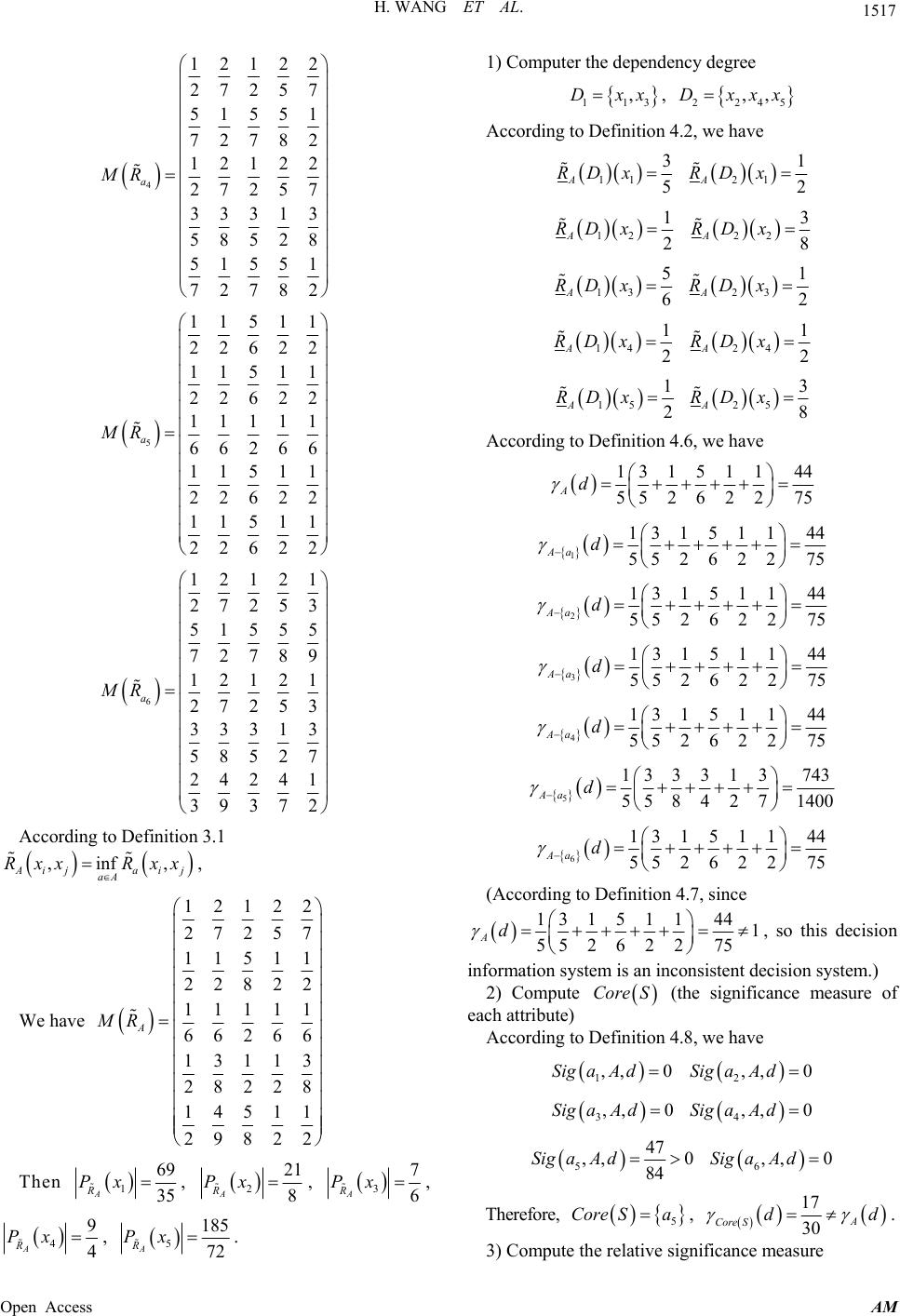 H. WANG ET AL. 1517 4 12122 27257 51551 72782 12122 27257 33313 58528 51551 72782 a MR 5 11511 22622 11511 22622 11111 66266 11511 22622 11511 22622 a MR 6 12121 27 2 5 3 515 55 72789 12121 27 2 5 3 33313 58527 24241 39372 a MR According to Definition 3.1 We have ,inf, Aij aij aA Rxx Rxx , 12122 27257 11511 22822 11111 66266 13113 28228 14511 2982 2 A MR Then 169 35 A R Px , 221 8 A R Px , 37 6 A R Px , . puter the depeency degree 49 4 A R Px 1) Comnd 113 ,Dxx, 2245 ,,Dxxx According Definition 4.2,e have to w , 5185 72 A R Px 11 3 A RD x5 21A RDx 1 2 12 2 A RD x1 22A RDx 3 8 13 5 6 A RDx 231 2 A RD x 14 1 2 A RDx 241 2 A RD x 15 1 2 A RDx 253 8 A RD x According to Definition 4 we have .6, 13 15 1144 55262275 Ad 1 131511 552622 Aa d 44 75 2 131511 44 55 2 6 2275 Aa d 3 131511 44 552622 75 Aa d 4 131511 44 55 2 6 2275 Aa d 5 13 3 3 13743 558427 1400 Aa d 6 131511 44 55 2 6 2275 Aa d (Accordin g t o Definition 4.7, since 13 151144 1 55262275 Ad , so this decision information system is an inconsistent decision system.) 2) Compute Core S (the significance measure of each attribute) According to Definition 4.8, we have 1,, 0SigaAd 2,,0SigaAd 3,,0aA dSig 4,,0SigaAd 547 6,,0SigaA d ,, 0 84 SigaA d Therefore, 5 Core Sa, 17 30 A Core Sdd . 3) Compute the relative significance measure O pen Access AM  H. WANG ET AL. 1518 Let , according to Definition 4.9, we have 5 BCoreS a 1 1, B Sig a44 171 75 3050 B Ba ddd 2 217 17 i, B Ba ga d 0 30 30 B Sd d 3 344 171 ,75 3050 BB Ba Siga ddd 4 444 171 ,75 3050 BB Ba Siga ddd 5 544 171 ,753050 BB Ba Siga ddd 6 644 171 ,753050 BB Ba Siga ddd 15 , 13151144 55 2 6 2275A aa d d 35 , 13151144 55262275 A aa d d 45 , 13 15 1144 55262275 A aa d d 56 , 13151144 55262275 A aa d d Hence,, , 15 ,aa 35 ,aa 45 ,aa s in interval and are the fuzzy reduct ued decision information system. We can conclude t product risk is the core influencing factor and market risk, operational risk, environmental risk and financial ris thnt influencing facrs. formation systems has attracted the attention of many scholars. introduce a fuzzy rough set model f heoretical Aspects of Reason- [2] J. H. Dai and H. W. Tian, “Fuzzy Rough Set Model For- set-Valued Dat, Vol. 229, 2013, pp. 54-68. http ss.2013.03.005 56 ,aa and set-val- positive region hat k are e importato 6. Conclusions It is well known that attribute reduction is a basic issue in rough set theory. Recently, the attribute reduction based on fuzzy rough set in decision in In this paper, we or interval and set-valued information systems by defining a fuzzy preference relation. The concepts of the signifi- cance measure of condition attributes and the relative significance measure of condition attributes are given in interval and set-valued decision information systems by the introduction of fuzzy positive region and the de- pendency degree. And on this basis, a heuristic algorithm for calculating fuzzy positive region reduction in interval and set-valued decision information systems is given. The results will help us to gain much more insights into the meaning of fuzzy rough set theory. Further more, it has provided a new perspective to study the attribute reduction problem in decision systems. 7. Acknowledgements This work is supported by the Natural Science Founda- tion of Shanxi Province in China (No. 2008011012). REFERENCES [1] Z. Pawlak, “Rough Sets: T ing about Data,” Kluwer Academic Publishers, Dordrecht, 1991. a,” Fuzzy Sets and Systems ://dx.doi.org/10.1016/j.f [3] Y. H. Qian, J. Y. Liang, W. Z. Wu and C. Y. Dang, “In- formation Granularity in Fuzzy Binary Grc Model,” IEEE Transactions on Fuzzy Systems, Vol. 19, No. 2, 2011, pp. 253-264. http://dx.doi.org/10.1109/TFUZZ.2010.2095461 [4] Z. Q. Meng and Z. Z. Shi, “Extended Rough Set-Based Attribute Reduction in Inconsistent Incomplete Decision Systems,” Information Sciences, Vol. 204, 2012, pp. 44- 69. http://dx.doi.org/10.1016/j.ins.2012.04.004 [5] T. Q. Deng, C. D. Yang and X. F. Wang, “A Reduct De- rived from Feature Selection,” Pattern Recognition Let- ters, Vol. 33, No. 12, 2012, pp. 1638-1646. http://dx.doi.org/10.1016/j.patrec.2012.03.028 [6] Y. J. Lin, J. J. Li and S. X. Wu, “Rough Set Theory in Interval and Set-Valued Information Systems,” Control and Decision, Vol. 26, No. 11, 2011, pp. 1611-1615. [7] R. C. Berredo, P. Y. Ekel and R. M. Palhares, “Fuzzy Preference Relations in Models of Decision Making,” Nonlinear Analysis, Vol . 63, N o . 5 - 7 , 2 0 0 5, p p . e 7 3 5 -e741. http://dx.doi.org/10.1016/j.na.2005.02.093 [8] E. Herrera-Viedma, F. Herrera, F. Chiclana and M. Luque, “Some Issues on Consistency of Fuzzy Preference Rela- tions,” European Journal of Operational Researcher, Vol. 154, No. 1, 2004, pp. 98-109. http://dx.doi.org/10.1016/S0377-2217(02)00725-7 [9] Q. H. Hu, D. R. Yu and M. Z. Guo, “Fuzzy Preference Based Rough Sets,” Information Sciences, Vol. 180, No. 10, 2010, pp. 2003-2022. http://dx.doi.org/10.1016/j.ins.2010.01.015 [10] Y. M. Wang and Z, P. Fan, “Fuzzy Preference Relations Aggregation and Weight Determination,” Computers & Industrial Engineering, Vol. 53, No. 1, 2007, pp. 163- 172. http://dx.doi.org/10.1016/j.cie.2007.05.001 [11] L. L. Lee, “Gr oup Decisi on Making with Inc o mplet e Fuzzy Preference Relations Based on the Additive Consistency and the Other Consistency Origi nal,” Experts Systems wi th Applications, Vol. 39, No. 14, 2012, pp. 11666-11676. http://dx.doi.org/10.1016/j.eswa.2012.04.043 [12] B. Zhu, “Studies on Consistency Measure of Hesitant Fuzzy Preference Relations,” Procedia Computer Science, Vol. 17, 2013, pp. 457-464. http://dx.doi.org/10.1016/j.procs.2013.05.059 [13] Y. H. Qian and J. Y. Liang, “Positive Approximation: A Accelerator for Attribute Reduction in Rough Set The- n ory,” Artificial Intelligence, Vol. 174, No. 9-10, 2010, pp. 597-618. http://dx.doi.org/10.1016/j.artint.2010.04.018 O pen Access AM 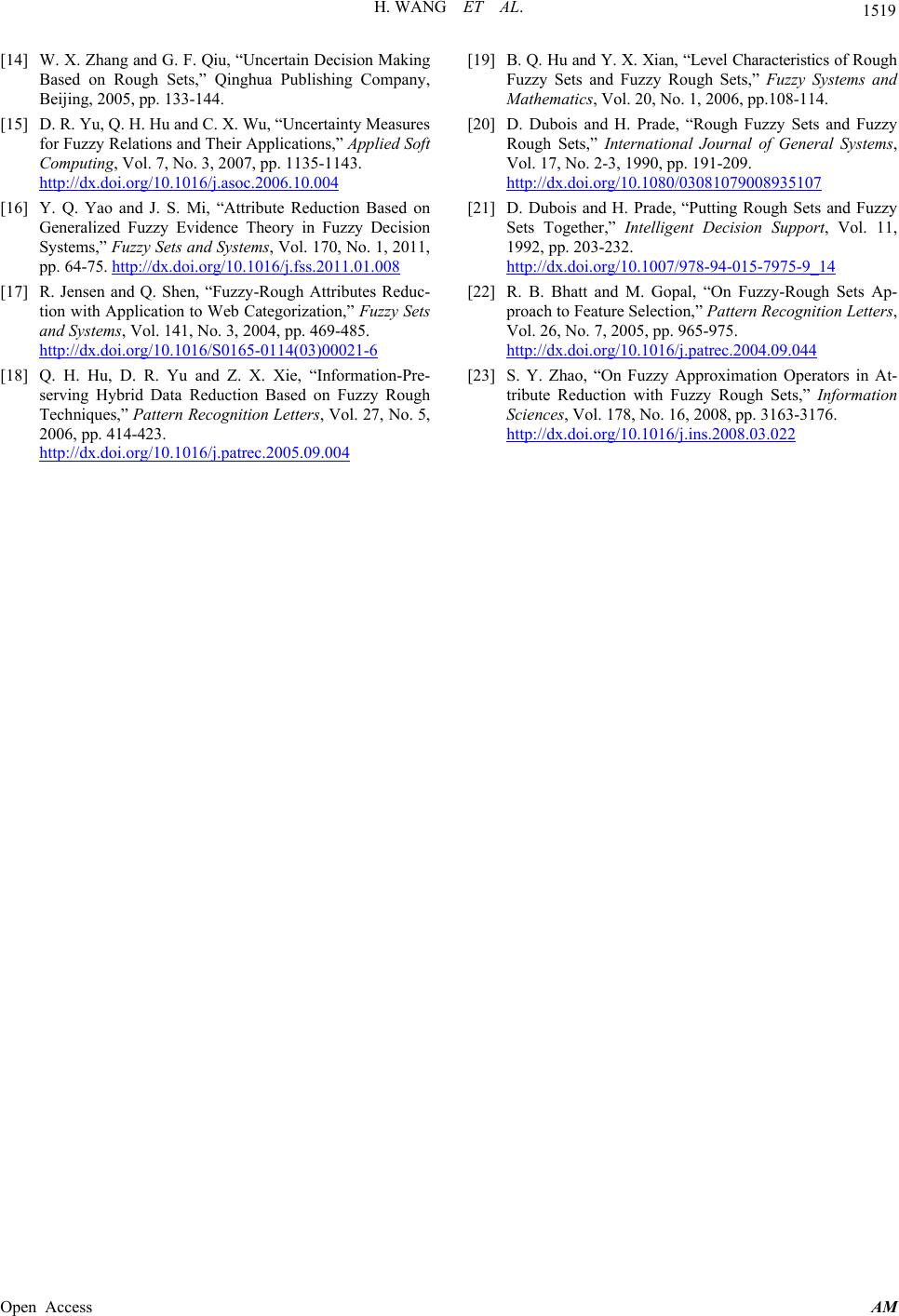 H. WANG ET AL. Open Access AM 1519 ghua Publishing Company [14] W. X. Zhang and G. F. Qiu, “Uncertain Decision Making Based on Rough Sets,” Qin Beijing, 2005, pp. 133-144. , [15] D. R. Yu, Q. H. Hu and C. X. Wu, “Uncertainty Measures for Fuzzy Relations and Their Applications,” Applied Soft Computing, Vol. 7, No. 3, 2007, pp. 1135-1143. http://dx.doi.org/10.1016/j.asoc.2006.10.004 [16] Y. Q. Yao and J. S. Mi, “Attribute Reduction Based on Generalized Fuzzy Evidence Theory in Fuzzy Decision Systems,” Fuzzy Sets and Systems, Vol. 170, No. 1, 2011, pp. 64-75. http://dx.doi.org/10.1016/j.fss.2011.01.008 [17] R. Jensen and Q. Shen, “Fuzzy-Rough Attributes Reduc- tion with Application to Web Categorization,” F and Systems, Vol. 141, No. 3, 2004, pp. 469-4uzzy Sets 85. http://dx.doi.org/10.1016/S0165-0114(03)00021-6 [18] Q. H. Hu, D. R. Yu and Z. X. Xie, “Information-Pre- serving Hybrid Data Reduction Based on Fuzzy Rough Techniques,” Pattern Recognition Letters, Vol. 27, No. 5, 2006, pp. 414-423. http://dx.doi.org/10.1016/j.patrec.2005.09.004 [19] B. Q. Hu and Y. X. Xian, “Level Characteristics of Rough Fuzzy Sets and Fuzz Mathematics, Vol. 20, No. 1, 2006, pp.108-114 y Rough Sets,” Fuzzy Systems and . [20] D. Dubois and H. Prade, “Rough Fuzzy Sets and Fuzzy Rough Sets,” International Journal of General Systems, Vol. 17, No. 2-3, 1990, pp. 191-209. http://dx.doi.org/10.1080/03081079008935107 [21] D. Dubois and H. Prade, “Putting Rough Sets and Fuzzy Sets Together,” Intelligent Decision 1992, pp. 203-232. Support, Vol. 11, http://dx.doi.org/10.1007/978-94-015-7975-9_14 [22] R. B. Bhatt and M. Gopal, “On Fuzzy-Rough Sets Ap- proach to Feature Sele Vol. 26, No. 7, 2005, pp. 965-975. ction,” Pattern Recognition Letters, http://dx.doi.org/10.1016/j.patrec.2004.09.044 [23] S. Y. Zhao, “On Fuzzy Approximation Operators in At- tribute Reduction with Fuzzy Rou Sciences, Vol. 178, No. 16, 2008, pp. 3163-317 gh Sets,” Information 6. http://dx.doi.org/10.1016/j.ins.2008.03.022
|